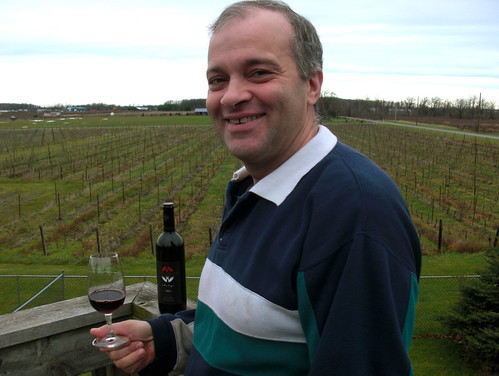
There really is no way to hide it. They surround the tiny winery in St. Davids. The rag-tag vineyards that have seen better days. And there are no signs at all of the harvest that has just ended in Niagara.
Maleta Winery is surviving, but it’s a struggle for Daniel Pambianchi, seen in the photo above from the Maleta estate home back porch) and his silent partners. It’s extremely hard for small wineries in Niagara to stay afloat. Many of them are for sale, including Maleta, but you won’t find a “for sale” posted on the front lawn. It just IS and for the right price it can be yours. You get a great property, winery, house, vineyards and a wine lifestyle. But be prepared for the endless hours of work, the never-ending pile of bills, the fixed costs of vineyard management, winemaking, bottling, sales and staff to keep the tasting room running. It goes on and on.
For now, Pambianchi is content making the six-hour drive from Montreal, where he lives, on weekends to make the wines along with consulting winemaker Arthur Harder. His former assistant winemaker, Michael Komar, left the winery in September.
Pambianchi is not unlike many winery owners in Niagara who are motivated by a love for wine. His passion started with making wine at home and is an accomplished home winemaker and author on the subject. He dreamed of turning his love for making wine into a commercial reality.
He had mentioned to Stan Maleta, the former owner of the winery, that if he ever wanted to sell the property he’d be interested. That day came eight years ago and the former software development executive and his partners ended up buying the winery lock, stock and barrel.

Timing is everything in the wine business. The 2003 vintage was a disaster with a tiny crop, 2004 was nothing special and 2005 was another short crop. Pambianchi was trying to make a statement with his wines, yet Mother Nature dealt him the worst stretch of vintages in recent memory. And 2006 wasn’t much better.
“I decided to follow my passion. But it’s a challenge,” says Pambianchi, sitting in a make-shift tasting area in the converted dining room in the Maleta estate house. We’re sitting on plastic lawn chairs while we taste through the current vintages of the Maleta wines, the worse-for-wear vineyards visible from the large dining room window.
Pambianchi is the author of Techniques in Home Winemaking: The Comprehensive Guide to Making Château-Style Wines and Wine, Myths, Facts and Snobberies, and is also a contributing author to WineMaker magazine as well as serving as Technical Editor. But nothing completely prepared him for the cool-climate reality of making wine in Niagara.
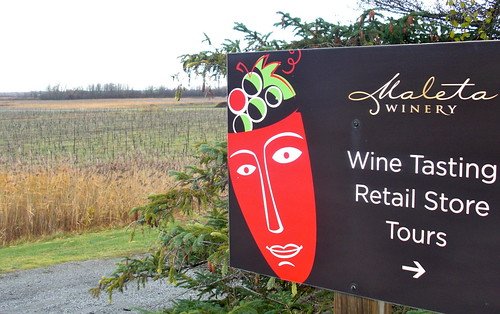
Maleta Vineyards and Estate Winery is located on Queenston Road in Niagara-on-the-Lake. The vineyard’s location and heritage make it desirable as it sits adjacent to what was once the Sunnieholme Winery, founded in 1918, and on what was probably the site of Niagara’s first commercial vineyard, developed in the mid 1800s.
The sloping land is situated in one of Niagara’s warmer mesoclimates, on what was once the shoreline of an ancient lakebed. The hard Haldimand clay soil was reconditioned with organic materials like straw and horse manure and under drained at every other row of vines.
The 14.5-acre vineyard is planted, though no crop was harvested in either 2011 or 2010, to traditional Bordeaux reds such as Cabernet Sauvignon, Cabernet Franc and Merlot, for blending into the flagship Meritage. Production also includes Gamay, Chardonnay and Riesling from 35-year-old vines as well as late harvest wines and Pinot Noir from purchased grapes. Pambianchi plans on getting the vineyards whipped into shape for the 2012 vintage, which will take some restoration of the vines and new plantings.
Pambianchi has changed the direction of Maleta with different tiers (Grape Brain for the value wines, View for the premium wines, the flagship Meritage and the First Frost Last Grape late harvest wines) and labels and has introduced a wonderful sparkling program under the View label.

He has two sparkling wines in the retail store including a traditionally made vintage dated Riesling and Rose. Both are exciting wines.
Maleta is a quality wine producer in Niagara that has flown under the radar, in part because it’s off the beaten track, but also because it doesn’t have the glitz and glamour of some of its more visible neighbours in St. Davids. Pambianchi appears to be on the right track with some quality wines on the shelves, an interesting sparkling program and a passion to make age-worthy wines to go with a lower-tier production of affordable wines.
Now, if only Mother Nature would give him a break in 2012 and beyond. Here’s what I tried and liked from Maleta’s current wines (you won’t find Maleta’s wines at the LCBO, only at the winery).
Maleta View Sparkling Rose 2008 ($30, 89 points) — This mid-tier wine is made from Cabernet Franc and Merlot in the traditional Champagne method. It spends 14 months on the lees. The nose is gorgeous with fresh strawberry, raspberry and toasty brioche notes. It’s made in an off-dry style with refreshing acidity, an exciting and vigorous mousse to go with an opulent array of red berries. Lovely wine.
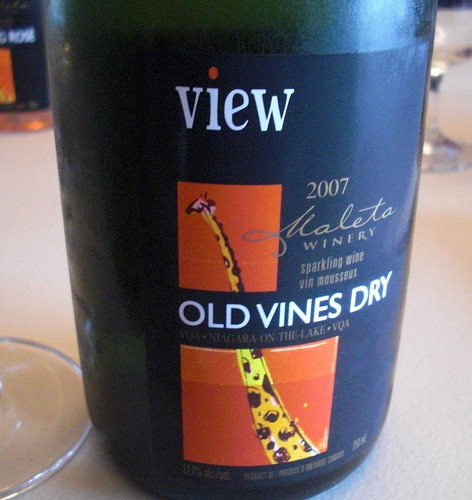 Maleta View Old Vines Dry Sparkling Riesling 2007 ($28, 91 points) — This will appeal to minerally-driven, petrol-loving Riesling fans. Pambianchi says this wine is “what makes it all worth it.” The wine spent 18 months on the lees and another year in bottle. It shows layers of mineral-petrol on the nose with citrus, apple and biscuit aromas. The palate reveals a wonderful assault of foamy bubbles, toast, and balancing acidity. This is one of the top sparking Rieslings made in Niagara.
Maleta View Old Vines Dry Sparkling Riesling 2007 ($28, 91 points) — This will appeal to minerally-driven, petrol-loving Riesling fans. Pambianchi says this wine is “what makes it all worth it.” The wine spent 18 months on the lees and another year in bottle. It shows layers of mineral-petrol on the nose with citrus, apple and biscuit aromas. The palate reveals a wonderful assault of foamy bubbles, toast, and balancing acidity. This is one of the top sparking Rieslings made in Niagara.
Maleta View Chardonnay 2007 ($19, 86 points) — There is very little of this Chardonnay left at the winery, and no more Chardonnay grown at the estate. The nose shows tropical fruit, pear and sweet spices but also some signs of aging. The mouth displays nice structure, some pear, apple and peach fruits and spices of clove and caramel with hints of mineral. Drinking well right now, but don’t hold long (like all 07 whites).
Maleta Grape Brain Riesling 2008 ($17, 87 points) — The Grape Brain Riesling is finished in an off-dry style with a nose of citrus and tropical fruit with just a whiff of mineral. It’s broader on the palate with grapefruit, melon, petrol and a kiss of honey. Great acid backbone to balance out the sweetness.
Maleta Grape Brain Rose Reserve 2009 ($16, 88 points) — Made primarily from Gamay planted in the 1960s in an off-dry style. I love the nose of cherry-raspberry and brambly fruit. It’s a meaty offering on the palate with bold red fruits and firm acidity that balances out the sweet notes.
Maleta Grape Brain Cab-Merlot 2006 ($16, 89 points) — Pambianchi likes to release his wines late. This was aged for four years in neutral oak barrels to give it just a hint of spice. It’s a lighter style but big on aromas of plum, cherry, cassis and soft spices. It’s perfectly mature on the palate with wonderful integrated fruit and spice all in balance. A bargain at this price for a mature Niagara red.
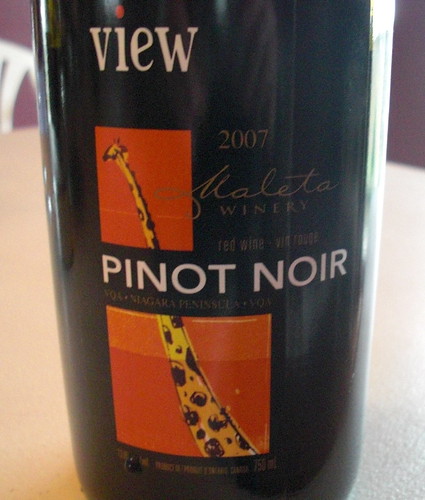 Maleta View Pinot Noir 2007 ($25, 88 points) — This is one of the more refined Pinots I have tasted from the hot and extracted 2007 vintage. The nose reveals cherry, kirsch and strawberry fruits with just a touch of wood spice. The fruits on the palate are extracted but not overdone with light oak spice and decent acidity.
Maleta View Pinot Noir 2007 ($25, 88 points) — This is one of the more refined Pinots I have tasted from the hot and extracted 2007 vintage. The nose reveals cherry, kirsch and strawberry fruits with just a touch of wood spice. The fruits on the palate are extracted but not overdone with light oak spice and decent acidity.
Maleta Meritage 2007 ($30, just being bottled now, 92 points) — This is Pambianchi’s signature wine (he’s selling the 2003 vintage now in the tasting room along with this new release) which is a blend of mostly Cabernet Sauvignon, Cabernet Franc and a touch of Merlot. It’s a serious wine that’s seriously delicious from an amazing vintage for Bordeaux variety wines. The nose shows intense notes of red fruits, mulberry, currant, bramble, blueberry, cloves and other sweet spices. It is big on the palate with a rich broth of cherry, cassis and a fruit-bowl of flavours to go with firm tannic structure and layers of spice. This has the fruit and tannins to age for many years. In fact, I wouldn’t open for at least a year. But when you do, wow!
Enjoy!


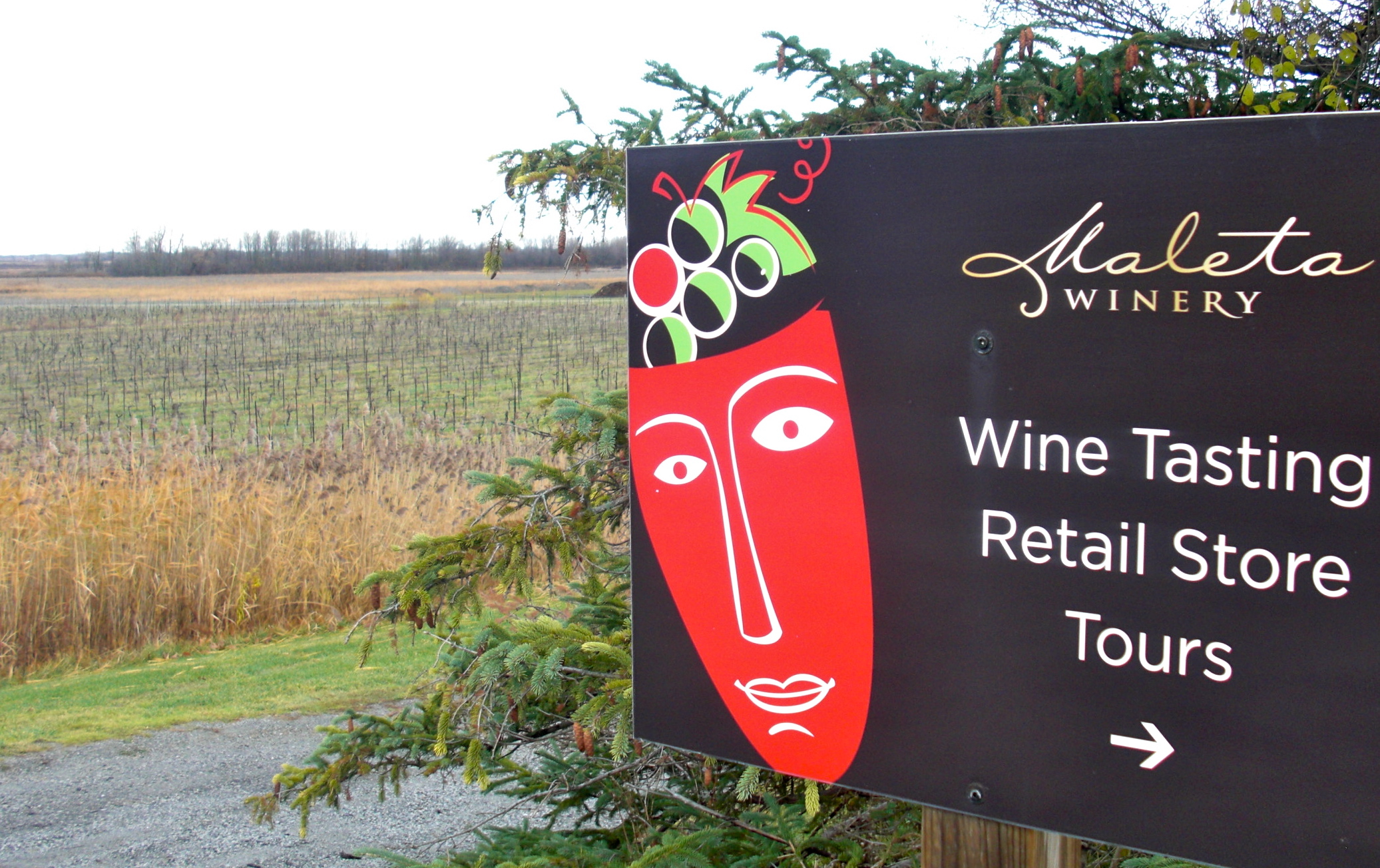



It’s “Daniel” not Paul.
Got it, thanks Fred.